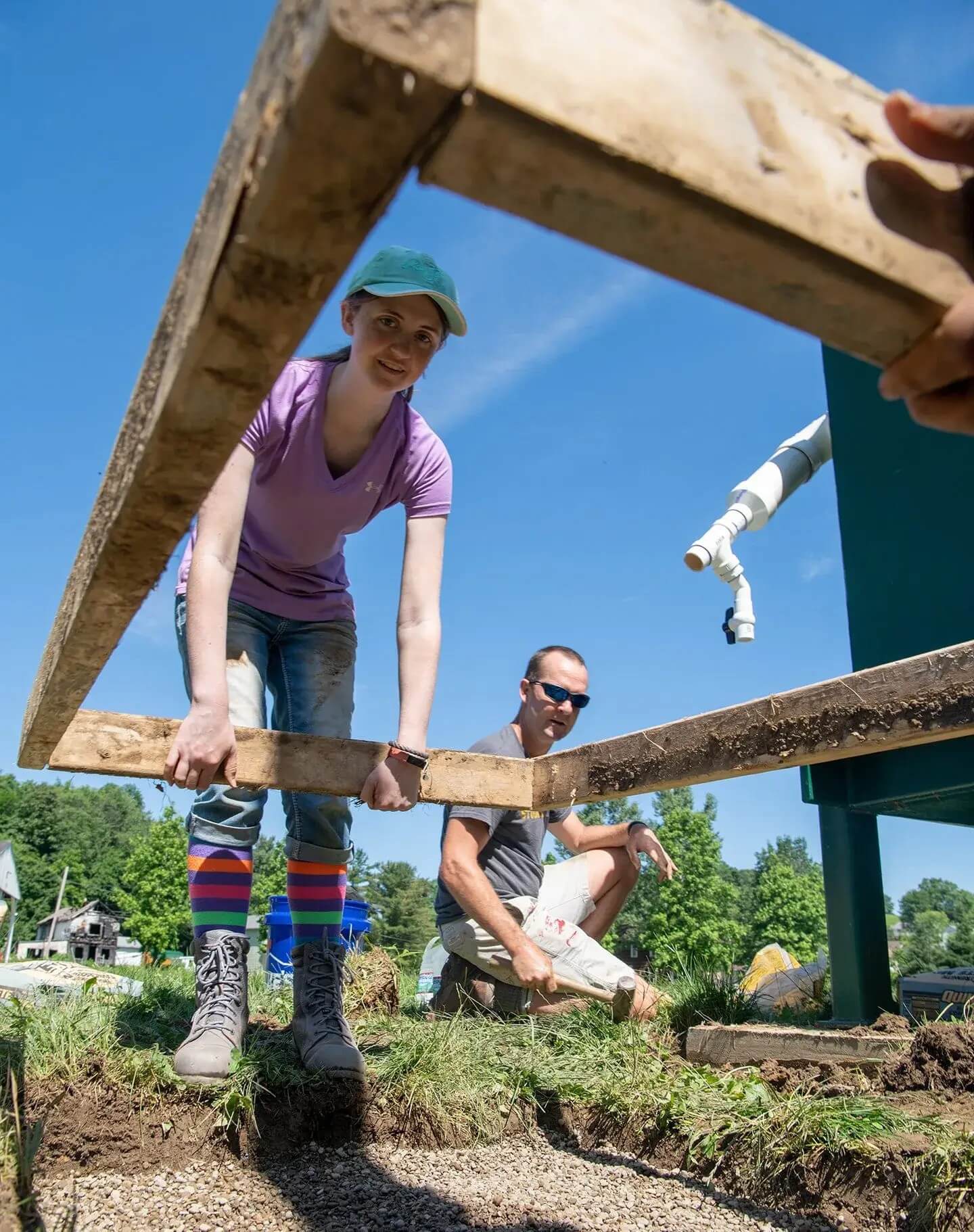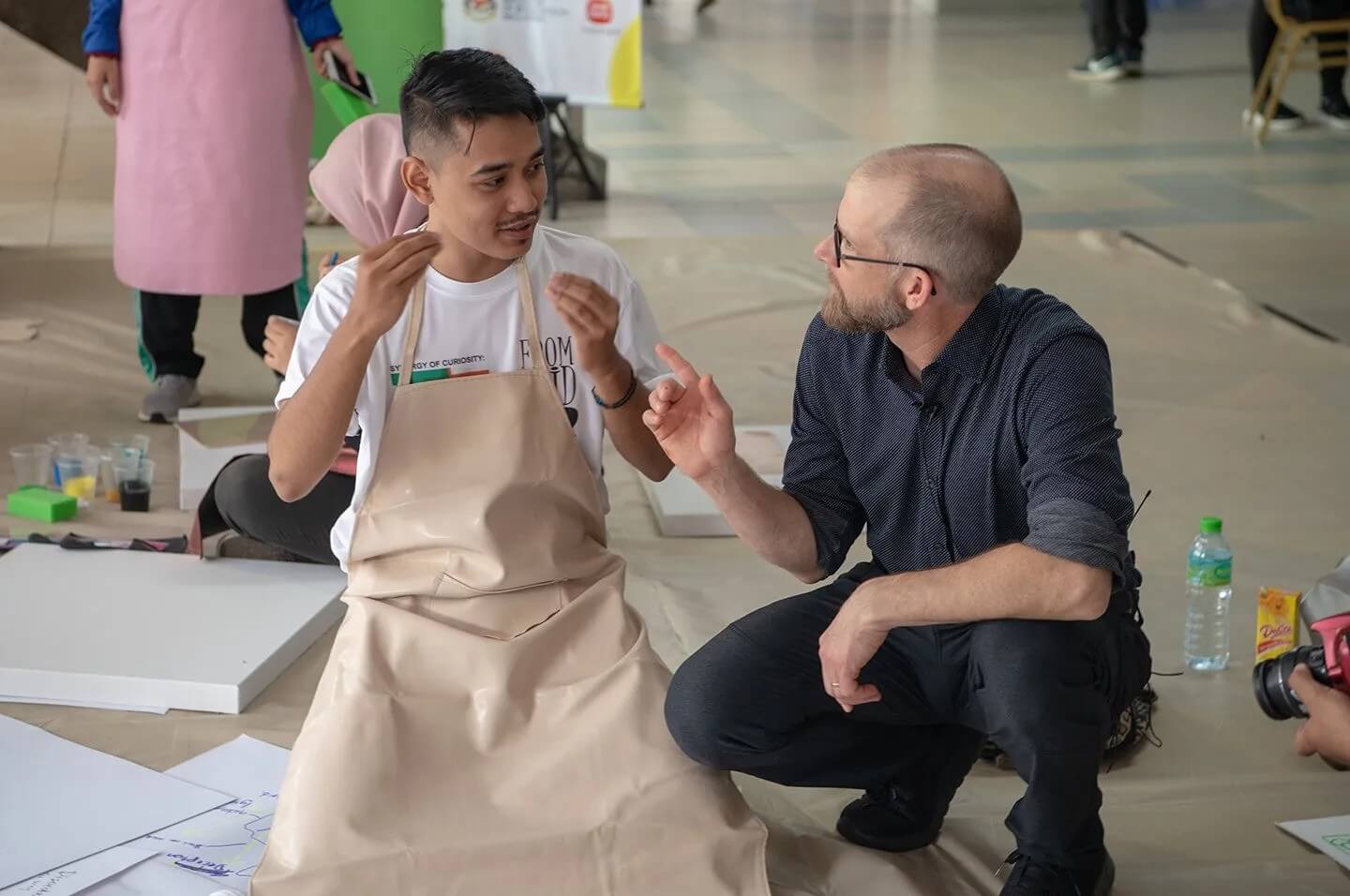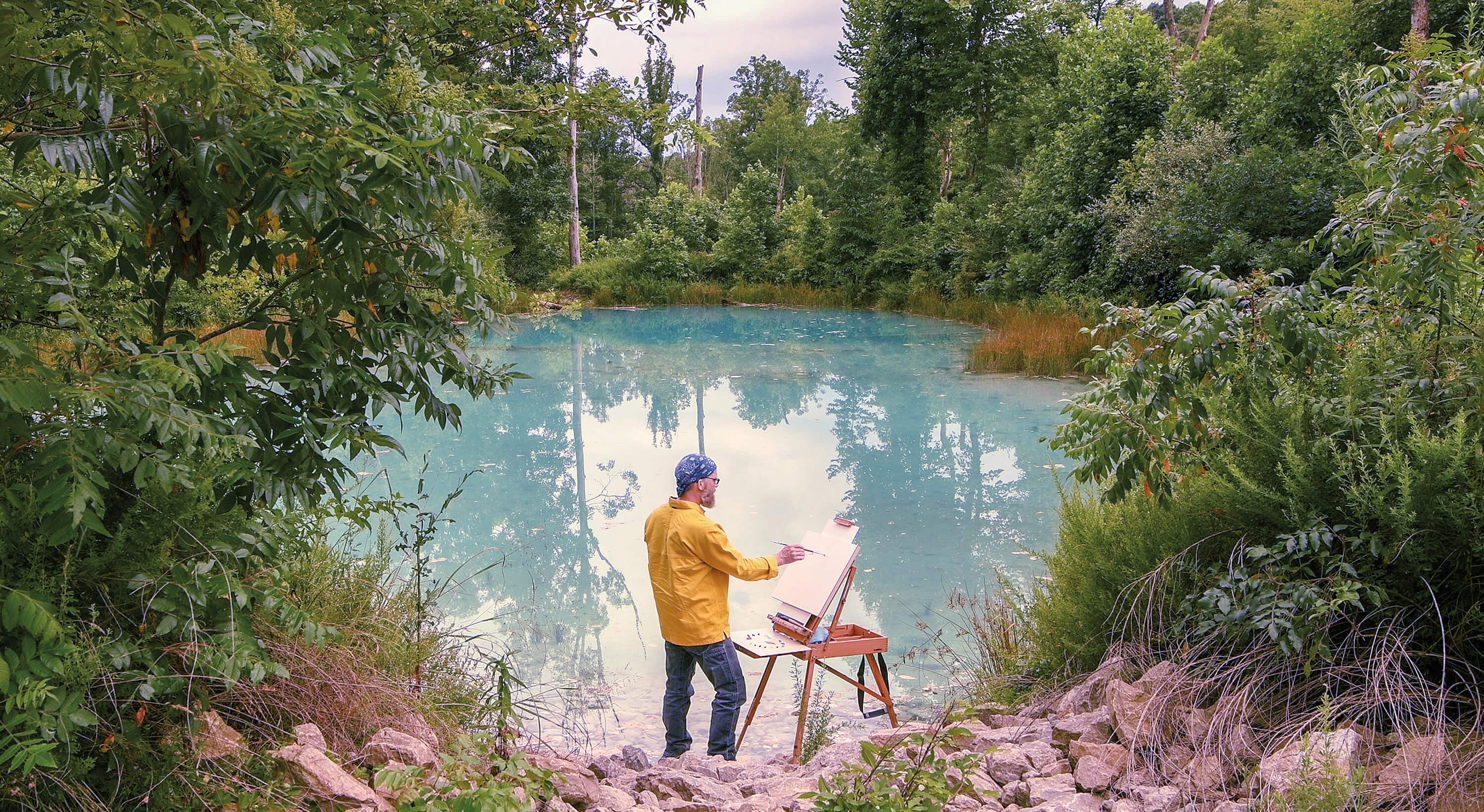Artist John Sabraw remembers driving through the Appalachian mountain range at dusk and thinking about color. “The hills take on this really interesting, earthy violet tone as the sun goes down,” he says.
Meanwhile, Russ College of Engineering and Technology Professor Guy Riefler and his students were creating a bench-scale process that removes toxic iron oxide from acid mine drainage, a pollutant produced by abandoned coal mines that dot the Appalachian landscape. Their mission? Mitigating damage to Ohio’s streams. Sabraw learned Riefler was essentially harvesting iron oxide, an element used to make paint pigment.
“The earliest paintings by mankind were made with iron oxide, from Rembrandts to Caravaggios,” says Sabraw, art professor and chair of OHIO’s Painting + Drawing program in the College of Fine Arts. “I thought, ‘Well, heck, could I make paint out of acid mine drainage?’”
A decade later, Sabraw and Riefler have done just that. Using their creativity and training, they are helping to heal the landscape in southeast Ohio by using the offending iron oxide to create paint pigment in partnership with Gamblin Artists Colors. With their students, they are turning pollution into paint (opens in a new window), acid into art.
Sabraw and Riefler’s creative collaboration has garnered worldwide recognition in media outlets like Smithsonian and Scientific American magazines, as well as Al Jazeera America.

The effort’s processing plant in Corning, Ohio, moves forward, with students and Riefler [RIGHT] laying the groundwork.
The effort was boosted recently when they launched a pilot-scale processing facility in Corning, Ohio, where abandoned mines empty acid mine drainage into the watershed. The facility is yet another collaboration between OHIO artists and engineers. Civil engineering and art students designed and built the mini plant, with funding support from Russ College alumnus Dick Dickerson, BSCE ’80, and his wife, Joan.
In the lab, we’re doing it in beakers and jars, and it’s fairly artificial,” explains Riefler. “[The facility] enables us to take the work from a lab out to a real, on-site environment and test the process.”
Sabraw and Riefler are joined by another steward of the landscape, Russ College Professor Srdjan Nesic, director of the Institute for Corrosion and Multiphase Technology (ICMT), renowned as the world’s largest corrosion lab. The Institute works with multinational oil companies like Exxon and Chevron to prevent pipeline corrosion and reduce the risk of catastrophic oil spills.
“We’ve developed knowledge in the form of software that enables [the companies] to predict and assess their risk of corrosion and where they have to put resources in order to mitigate it,” says Nesic, who has been at ICMT’s helm since 2002.
The “Acid to Art” technology is in its infancy, while ICMT’s work is mature. Yet both efforts share a core mission of stewarding the Earth’s waterways and landscape and developing technology and knowledge that revive and protect both.
Growing in Knowledge, Wisdom & Love
These creative problem solvers took their technologies and know-how on the road in December 2018 to Malaysia to visit with colleagues at OHIO’s partner university Universiti Teknologi MARA (UiTM) and Taylor’s University.
Collaboration, sharing technologies, building on solution-based research, and learning about each other’s culture marked the delegation’s goals for the trip [see below]. Sabraw led art workshops at UiTM and at Taylor’s University, while Riefler led chemistry experiments with engineering students at both schools.
At Taylor’s, Sabraw demonstrated the technology and created paint pigments with students who used them to produce two-foot by two-foot paintings that were later sold at the Distinguished Tun Abdul Razak Lecture to support research on autism.

Sabraw collaborates with a student at the Taylor’s University workshop.
“To see the generosity and equal interest in idealism from those students was such a reward for me,” says Sabraw. “[Our aim was] to combine art and science [to empower students] to solve problems in their own region.”
Nesic met with Datuk Ahmad Nizam Salleh, who was appointed as chair of Malaysia-based PETRONAS oil company in August 2018 by Malaysia’s Prime Minister, Tun Mahathir bin Mohamad. The ICMT and PETRONAS agreed to continue their relationship and embark on a new phase of its ongoing software development project.
The trip to PETRONAS headquarters was Nesic’s third—yet this one was different. Nesic learned that Salleh is one of 2,400 OHIO alumni living in Malaysia, the country that boasts the largest number of alumni outside of the United States. Salleh earned a bachelor’s degree in business administration in 1979.“It was completely fortuitous,” Nesic says.
The work continues back in Athens. That color Sabraw saw at dusk in the Appalachian landscape? It was made into a Gamblin oil paint pigment called Reclaimed Earth Violet using the “pollution into paint” method. And the work that ICMT will do with PETRONAS? Nesic says the new research phase should bring new graduate students working as PETRONAS employees from Malaysia to work with ICMT’s researchers.
It’s all part of the ripple effect that Sabraw, Riefler, Nesic, and their students create to revive and protect the landscape.
Building intellectual bridges
The special relationship between Ohio University and Malaysia is grounded in OHIO’s singular Tun Abdul Razak Chair program. Since 1979, 15 senior Malaysian scholars have been appointed as chairs at the Athens campus, teaching, conducting research, and building intellectual bridges between the two countries.
Sabraw gave the keynote presentation for the Distinguished Tun Abdul Razak Lecture in Kuala Lumpur during the OHIO delegation’s visit in December 2018. In introducing Sabraw and his lecture, “Synergy of Curiosity: From Acid to Art,” OHIO President M. Duane Nellis hailed both Sabraw and Riefler’s work as a “global inspiration.” More OHIO key leaders traveled with the delegation, including Lorna Jean Edmonds, vice provost for Global Affairs and International Studies; Nico Karagosian, vice president of University Advancement and president and CEO of The Ohio University Foundation; Renee Middleton, dean of the Gladys W. and David H. Patton College of Education; Joe Shields, vice president for research and creative activity and dean of the Graduate College; and Hugh Sherman, dean of the College of Business.
Sabraw says he was inspired by what he learned from his Malaysian colleagues and by how they are addressing their own environmental challenges.
“The experience gave me a strong desire to try to create a more permanent bridge to other cultures, particularly Southeast Asia,” he says. “The value of it for our students and for analysis of our own programs can’t be overestimated.”
Photos and video by Ben Wirtz Siegel, BSVC ’02



